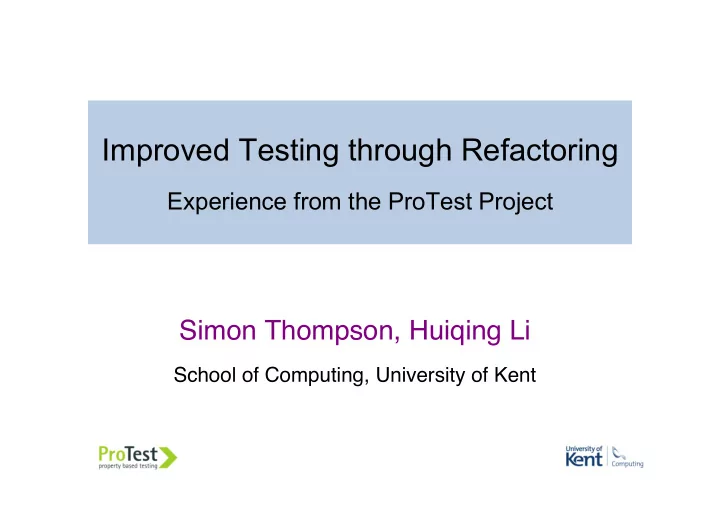

Improved Testing through Refactoring Experience from the ProTest Project Simon Thompson, Huiqing Li School of Computing, University of Kent
Background Modify Refactor
Wrangler Interactive refactoring tool for Erlang Clone Improve Integrated into Emacs detection module and Eclipse / ErlIDE + removal structure Multiple modules Structural, process, Basic refactorings macro refactorings
Refactoring and testing • Clone detection and elimination in test code • Property extraction through clone detection. • Refactoring code and tests: frameworks. • Refactoring tests in a framework.
Refactoring and testing • Clone detection and elimination in test code • Property extraction through clone detection. • Refactoring code and tests: frameworks. • Refactoring tests in a framework.
What is ʻ similar ʼ code? X+Y (X+3)+4 (X+3)+4 4+(5-(3*X)) 4+(5-(3*X)) The anti-unification gives the (most specific) common generalisation.
SIP case study SIP message manipulation allows rewriting rules to transform messages. Test by smm_SUITE.erl , 2658 LOC. 2658 to 2042 in twelve steps.
Step 1 The largest clone class has 15 members. The suggested function has no parameters, so the code is literally repeated.
Not step 1 The largest clone has 88 lines, and 2 parameters. But what does it represent? What to call it? Best to work bottom up.
The general pattern Identify a clone. Introduce the corresponding generalisation. Eliminate all the clone instances. So what ʼ s the complication?
What is the complication? Which clone to choose? Include all the code? How to name functions and variables? When and how to generalise? 'Widows' and 'orphans'
Step 3 23 line clone occurs; new_fun() -> {FilterKey1, FilterName1, FilterState, FilterKey2, choose to replace a FilterName2} = create_filter_12(), ?OM_CHECK([#smmFilter{key=FilterKey1, filterName=FilterName1, smaller clone. filterState=FilterState, module=undefined}], ?SGC_BS, ets, lookup, [smmFilter, FilterKey1]), ?OM_CHECK([#smmFilter{key=FilterKey2, filterName=FilterName2, filterState=FilterState, Rename function module=undefined}], ?SGC_BS, ets, lookup, [smmFilter, FilterKey2]), and parameters, ?OM_CHECK([#sbgFilterTable{key=FilterKey1, sbgFilterName=FilterName1, sbgFilterState=FilterState}], and reorder them. ?MP_BS, ets, lookup, [sbgFilterTable, FilterKey1]), ?OM_CHECK([#sbgFilterTable{key=FilterKey2, sbgFilterName=FilterName2, sbgFilterState=FilterState}], check_filter_exists_in_sbgFilterTable(FilterKey, FilterName, FilterState) -> ?MP_BS, ets, lookup, [sbgFilterTable, FilterKey2]), ?OM_CHECK([#sbgFilterTable{key=FilterKey, {FilterName2, FilterKey2, FilterKey1, FilterName1, sbgFilterName=FilterName, FilterState}. sbgFilterState=FilterState}], ?MP_BS, ets, lookup, [sbgFilterTable, FilterKey]).
Steps 4, 5 2 variants of check_filter_exists_in_sbgFilterTable … • Check for the filter occurring uniquely in the table: call to ets:tab2list instead of ets:lookup . • Check a different table, replace sbgFilterTable by smmFilter . • Don ʼ t generalise: too many parameters, how to name? check_filter_exists_in_sbgFilterTable(FilterKey, FilterName, FilterState) -> ?OM_CHECK([#sbgFilterTable{key=FilterKey, sbgFilterName=FilterName, sbgFilterState=FilterState}], ?MP_BS, ets, lookup, [sbgFilterTable, FilterKey]).
Step 10 ʻ Widows ʼ and new_fun(FilterName, NewVar_1) -> FilterKey = ?SMM_CREATE_FILTER_CHECK(FilterName), %%Add rulests to filter ʻ orphans ʼ in RuleSetNameA = "a", RuleSetNameB = "b", RuleSetNameC = "c", clone RuleSetNameD = "d", ... 16 lines which handle the rules sets are elided ... identification. %%Remove rulesets NewVar_1, {RuleSetNameA, RuleSetNameB, RuleSetNameC, RuleSetNameD, FilterKey}. Avoid passing new_fun(FilterName, FilterKey) -> commands as %%Add rulests to filter RuleSetNameA = "a", parameters? RuleSetNameB = "b", RuleSetNameC = "c", RuleSetNameD = "d", ... 16 lines which handle the rules sets are elided ... Also at step 11. %%Remove rulesets {RuleSetNameA, RuleSetNameB, RuleSetNameC, RuleSetNameD}.
Clone elimination and testing Copy and paste … many hands. Shorter, more comprehensible and better structured code. Emphatically not “push button” … Need domain expert involvement.
Refactoring and testing • Clone detection and elimination in test code • Property extraction through clone detection. • Refactoring code and tests: frameworks. • Refactoring tests in a framework.
Property discovery in Wrangler Find (test) code that Example: is similar … Test code from … build a common Ericsson: different abstraction media and codecs. … accumulate the Generalisation to all instances medium/codec combinations. … and generalise the instances.
Refactoring and testing • Clone detection and elimination in test code • Property extraction through clone detection. • Refactoring code and tests: frameworks. • Refactoring tests in a framework.
Testing frameworks Extend refactorings EUnit, Common Test and while observing Quick Check each give a template for writing tests • Naming conventions and a platform for • Macros performing them. • Callbacks • Meta-programming Want to refactor code • Coding patterns and test code in step.
Quick Check example Callbacks, macros and meta-programming. -export( …, command/1, postcondition/3, … ,prop/0]). command({N}) when N<10 -> frequency([{3,{call,nat_gen,next,[]}}, {1,{call,nat_gen,stop,[]}}]); … postcondition({N},{call,nat_gen,next,_},R)-> R == N; … prop() -> ?FORALL(Commands,commands(?MODULE), begin {_H,_S,Result} = run_commands(?MODULE,Commands), Result == ok end).
Quick Check example Callbacks, macros and meta-programming. -export( …, command/1, postcondition/3, … ,prop/0]). command({N}) when N<10 -> frequency([{3,{call,nat_gen,next,[]}}, {1,{call,nat_gen,stop,[]}}]); … postcondition({N},{call,nat_gen,next,_},R)-> R == N; … prop() -> ?FORALL(Commands,commands(?MODULE), begin {_H,_S,Result} = run_commands(?MODULE,Commands), Result == ok end).
Refactoring and testing • Clone detection and elimination in test code • Property extraction through clone detection. • Refactoring code and tests: frameworks. • Refactoring tests in a framework.
Refactoring within QuickCheck FSM-based testing: Property refactorings: transform state Introduce local variable from simple definitions (LET) value to record. Stylised usage Merge local defini- supports robust tions and quantifiers transformation. (FORALL). Spinoff to OTP libs. [EUnit too …]
Refactoring and testing • Clone detection and elimination in test code • Property extraction through clone detection. • Refactoring code and tests: frameworks. • Refactoring tests in a framework.
www.cs.kent.ac.uk/projects/wrangler/ → GettingStarted
Recommend
More recommend